Remote Homecoming Chapter Two
Curated by Amirali Ghasemi
Remote Homecoming Chapter Two
Curated by Amirali Ghasemi / From Parking Video Library
Remote Homecoming is a platform designed to bring videos made by Iranians across the border remotely back home, and to bridge the gap between so called “inside” and “outside”, while acknowledging.these terms are fading rather quickly or at least are changing tremendously as we speak, still there are numerous obstacles to communicate between the scenes and there is a lot to be learnt. Chapter one of remote homecoming was a selection of short films, videos and performances from a wide range of Iranian artists from emerging to established and tried to show a gradient of practices across various disciplines and mediums, and was premiered at Limited Access 3 in Tehran & London. The 2nd edition of this program hopes for widening the definition of the medium by sharing variety of approaches, frameworks and mediums. To imagine an aperture to what is yet unseen even in this post-social network era we live in.
Ever decreasing level of attention span, with massive flux of data running on shallow and fragmented streams, one should appreciate having offline time, pretending everything is not about having fastest access to “the latest” and to start having faith in “the slowness” again.
Curated by Amirali Ghasemi / From Parking Video Library
Remote Homecoming is a platform designed to bring videos made by Iranians across the border remotely back home, and to bridge the gap between so called “inside” and “outside”, while acknowledging.these terms are fading rather quickly or at least are changing tremendously as we speak, still there are numerous obstacles to communicate between the scenes and there is a lot to be learnt. Chapter one of remote homecoming was a selection of short films, videos and performances from a wide range of Iranian artists from emerging to established and tried to show a gradient of practices across various disciplines and mediums, and was premiered at Limited Access 3 in Tehran & London. The 2nd edition of this program hopes for widening the definition of the medium by sharing variety of approaches, frameworks and mediums. To imagine an aperture to what is yet unseen even in this post-social network era we live in.
Ever decreasing level of attention span, with massive flux of data running on shallow and fragmented streams, one should appreciate having offline time, pretending everything is not about having fastest access to “the latest” and to start having faith in “the slowness” again.
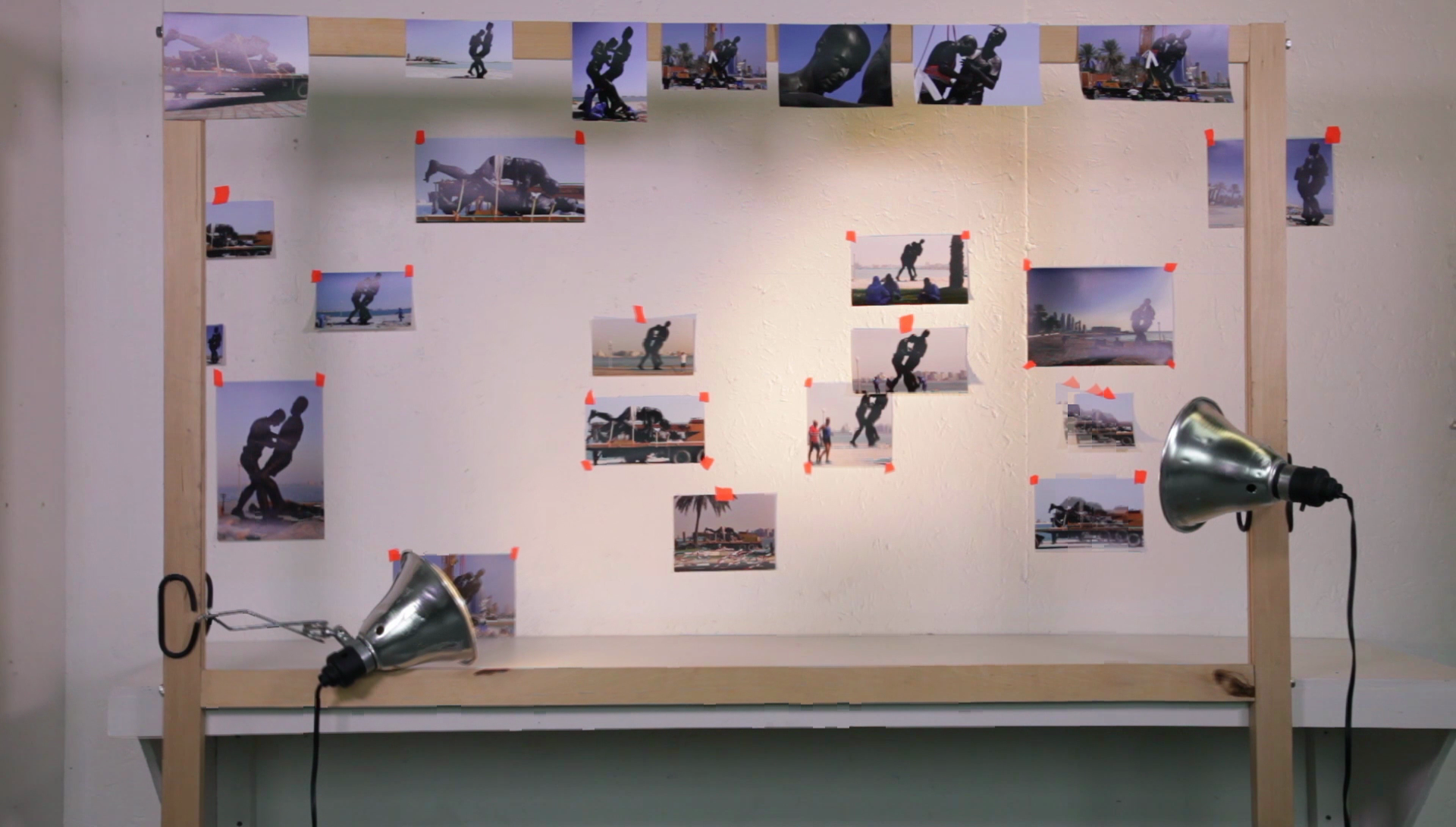
Sanaz Sohrabi
Auxiliary Mirrors
2010
00:01:38
“Auxiliary Mirrors” is an experimental video-essay set around the ‘status of image’, its materiality and the latent narratives it can or cannot make visible; in other words, what is visible and inside the frame becomes tantamount to what is missing and out-of-frame. Auxiliary Mirrors analyzes four sets of archival videos and images in order to investigate the role of cameras in formation of historical narratives and collective memory. It further discusses the anonymity and multiplicity of conditions and actors in creating what we come to know as an “iconic” image. Structured as an essay, it looks at the frame of an image as a container of space, bodies, and stories, once taken out of its chronological order can be reframed and plotted into another narrative.
Auxiliary Mirrors studies (moving)images not as entities with a linear lifespan but rather as things that are always in process of becoming and following Derrida, looking at their archival status as being malleable, can alter their future and afterlife.
Auxiliary Mirrors
2010
00:01:38
“Auxiliary Mirrors” is an experimental video-essay set around the ‘status of image’, its materiality and the latent narratives it can or cannot make visible; in other words, what is visible and inside the frame becomes tantamount to what is missing and out-of-frame. Auxiliary Mirrors analyzes four sets of archival videos and images in order to investigate the role of cameras in formation of historical narratives and collective memory. It further discusses the anonymity and multiplicity of conditions and actors in creating what we come to know as an “iconic” image. Structured as an essay, it looks at the frame of an image as a container of space, bodies, and stories, once taken out of its chronological order can be reframed and plotted into another narrative.
Auxiliary Mirrors studies (moving)images not as entities with a linear lifespan but rather as things that are always in process of becoming and following Derrida, looking at their archival status as being malleable, can alter their future and afterlife.
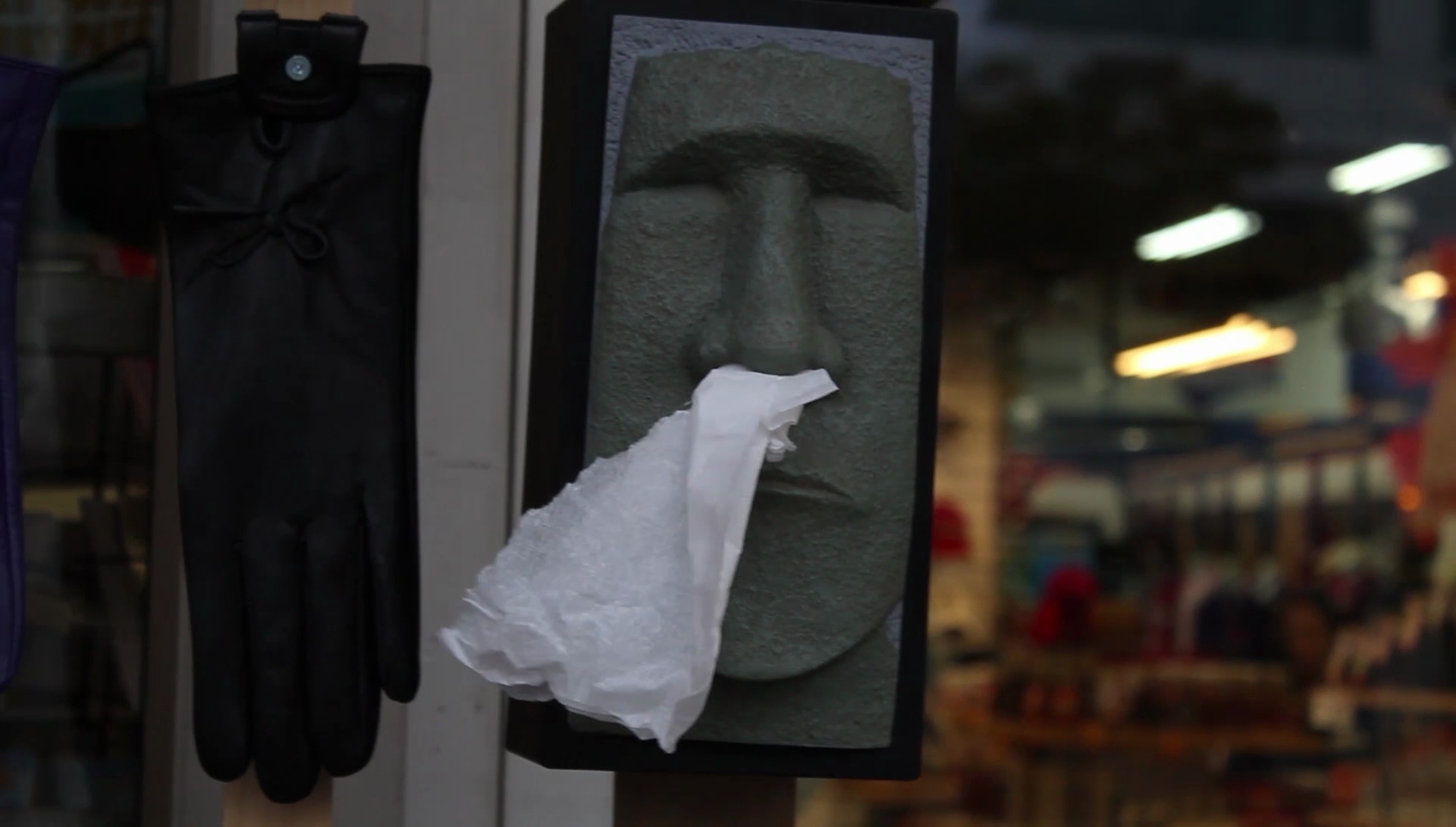
Faraz Anoushahpour, Parastoo Anoushahpour, Ferko Konneman
There is a Woman a Texting in Front of Dark Horse
2013
00:07:00
Video and site-specific screening made in collaboration with Nina Konnemann, Faraz Anoushahpour, & Parastoo Anoushapour. The window of room 8309 at Super8 Hotel on Spadina Ave perfectly frames an unexceptional view – an intersection with a corner coffee shop. There is a Woman Texting in Front of the Dark Horse investigates this site, adding a layer of narrative tension to a nonfictional, photographic depiction of an actual location. A frantic telephone dialogue seems to direct the camera’s gaze as a sense of real-time surveillance is upset by jump cuts and repeated moments, creating a narrative with simultaneously amusing and sinister undertones..
There is a Woman a Texting in Front of Dark Horse
2013
00:07:00
Video and site-specific screening made in collaboration with Nina Konnemann, Faraz Anoushahpour, & Parastoo Anoushapour. The window of room 8309 at Super8 Hotel on Spadina Ave perfectly frames an unexceptional view – an intersection with a corner coffee shop. There is a Woman Texting in Front of the Dark Horse investigates this site, adding a layer of narrative tension to a nonfictional, photographic depiction of an actual location. A frantic telephone dialogue seems to direct the camera’s gaze as a sense of real-time surveillance is upset by jump cuts and repeated moments, creating a narrative with simultaneously amusing and sinister undertones..
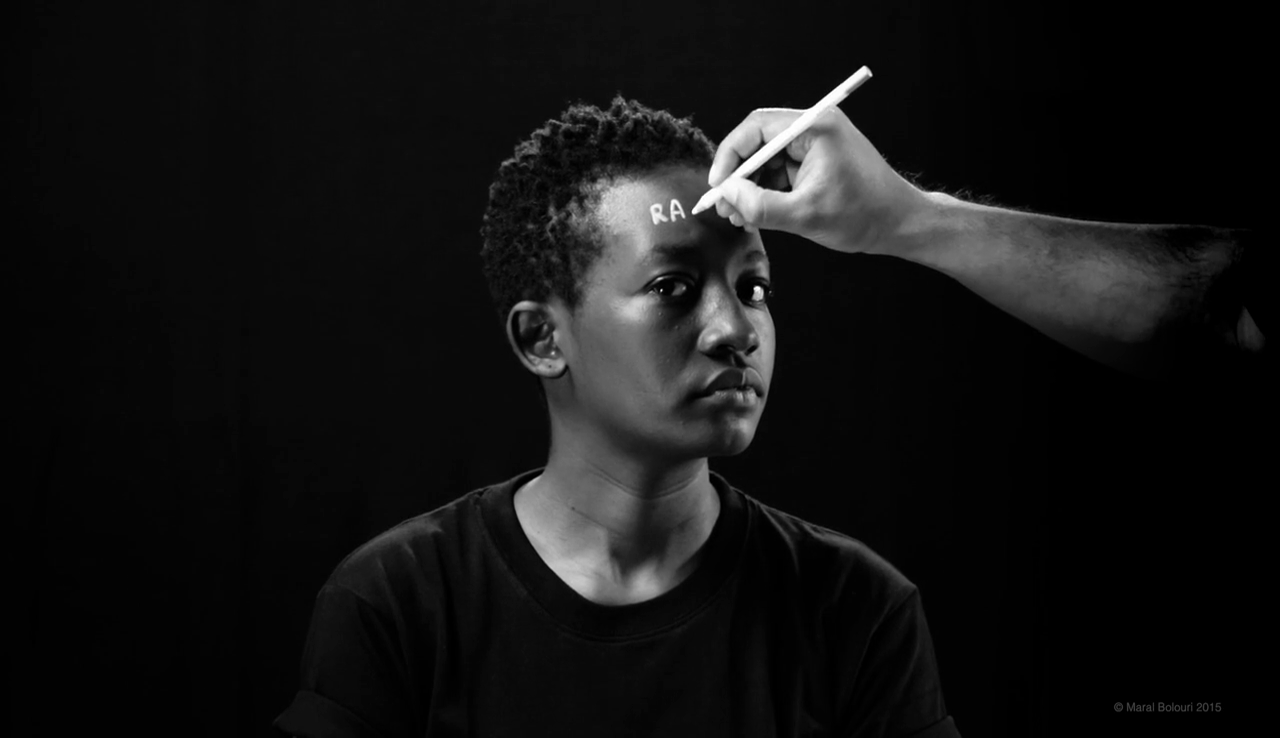
Maral Bolouri
Destiny
2015
00:02:34
Destiny aims to challenge gender based stereotypes in different cultures. In this video I brought together individuals from different countries and cultures where we engaged in discussions about gender stereotypes. Each participant chose a stereotype from their language to work with, within the production of this artwork. The video consists of two parts.
The first part addresses the process of socialization by which people are taught to accept roles and functions, fixed by society. In this regard participants portray a passive presence by allowing their peers label their foreheads.
The second part pictures the internalization of the social norms by the individuals, where each participant plays an active role by symbolically accepting the stereotype. In this process they “Become” the system that reinforces the social construction of gender.
Destiny
2015
00:02:34
Destiny aims to challenge gender based stereotypes in different cultures. In this video I brought together individuals from different countries and cultures where we engaged in discussions about gender stereotypes. Each participant chose a stereotype from their language to work with, within the production of this artwork. The video consists of two parts.
The first part addresses the process of socialization by which people are taught to accept roles and functions, fixed by society. In this regard participants portray a passive presence by allowing their peers label their foreheads.
The second part pictures the internalization of the social norms by the individuals, where each participant plays an active role by symbolically accepting the stereotype. In this process they “Become” the system that reinforces the social construction of gender.
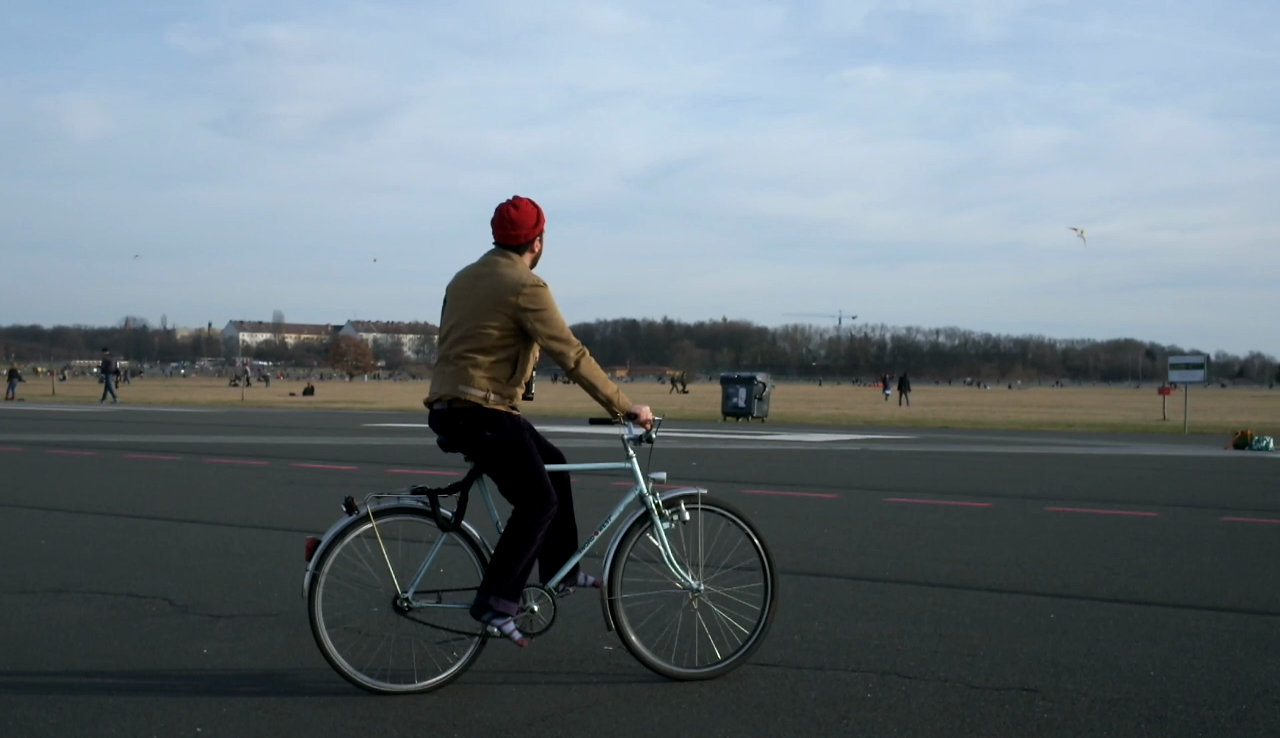
Rahi Sinaki
Tempelhof
2017
00:03:48
The upcoming video is made of pictures I took from closed airport 'Tempelhof' in Berlin. This airport is the inspiration and somehow the creator of the music we hear. The music which I wrote for oboe, violin, piano and electronic and recorded in Vienna.
It sounds as if they are the translations of each other and together give a sense that wouldn't exist if any of them was missing.
Tempelhof
2017
00:03:48
The upcoming video is made of pictures I took from closed airport 'Tempelhof' in Berlin. This airport is the inspiration and somehow the creator of the music we hear. The music which I wrote for oboe, violin, piano and electronic and recorded in Vienna.
It sounds as if they are the translations of each other and together give a sense that wouldn't exist if any of them was missing.
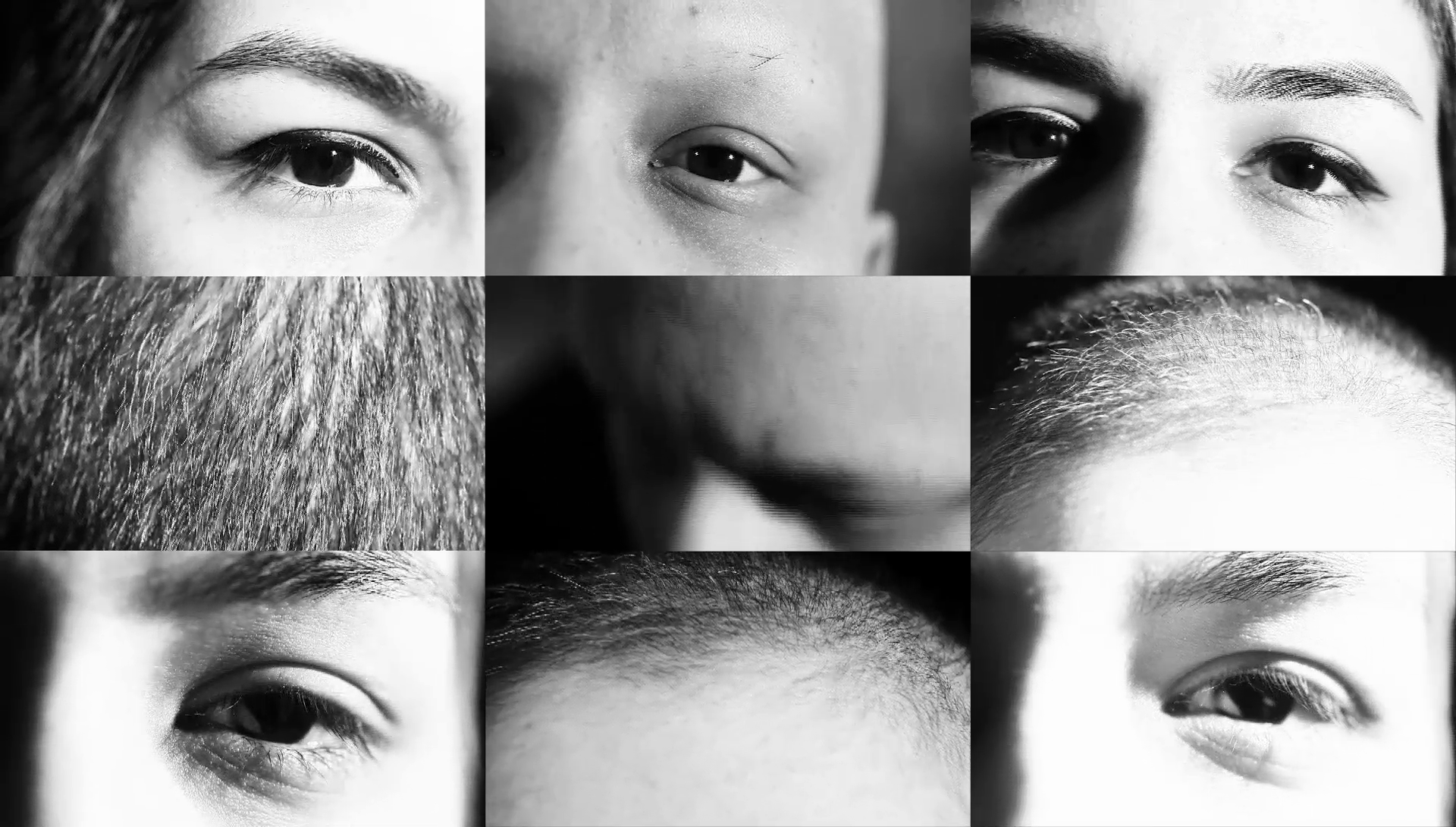
Niloufar Keyhani, Gilda Nowparast
Point to Point
2015
00:05:22
I During my time of disability caused by The treatment I was receiving, I knew it would only be transient.I felt like a tree exposing its bare branches to The flakes ofsnow in winter calling out "fall, fall."Cancer was like flakes of snow which fell on my body giving me the power of a huge avalanche.I am now looking forward to spring, a time to blossom.
Point to Point
2015
00:05:22
I During my time of disability caused by The treatment I was receiving, I knew it would only be transient.I felt like a tree exposing its bare branches to The flakes ofsnow in winter calling out "fall, fall."Cancer was like flakes of snow which fell on my body giving me the power of a huge avalanche.I am now looking forward to spring, a time to blossom.
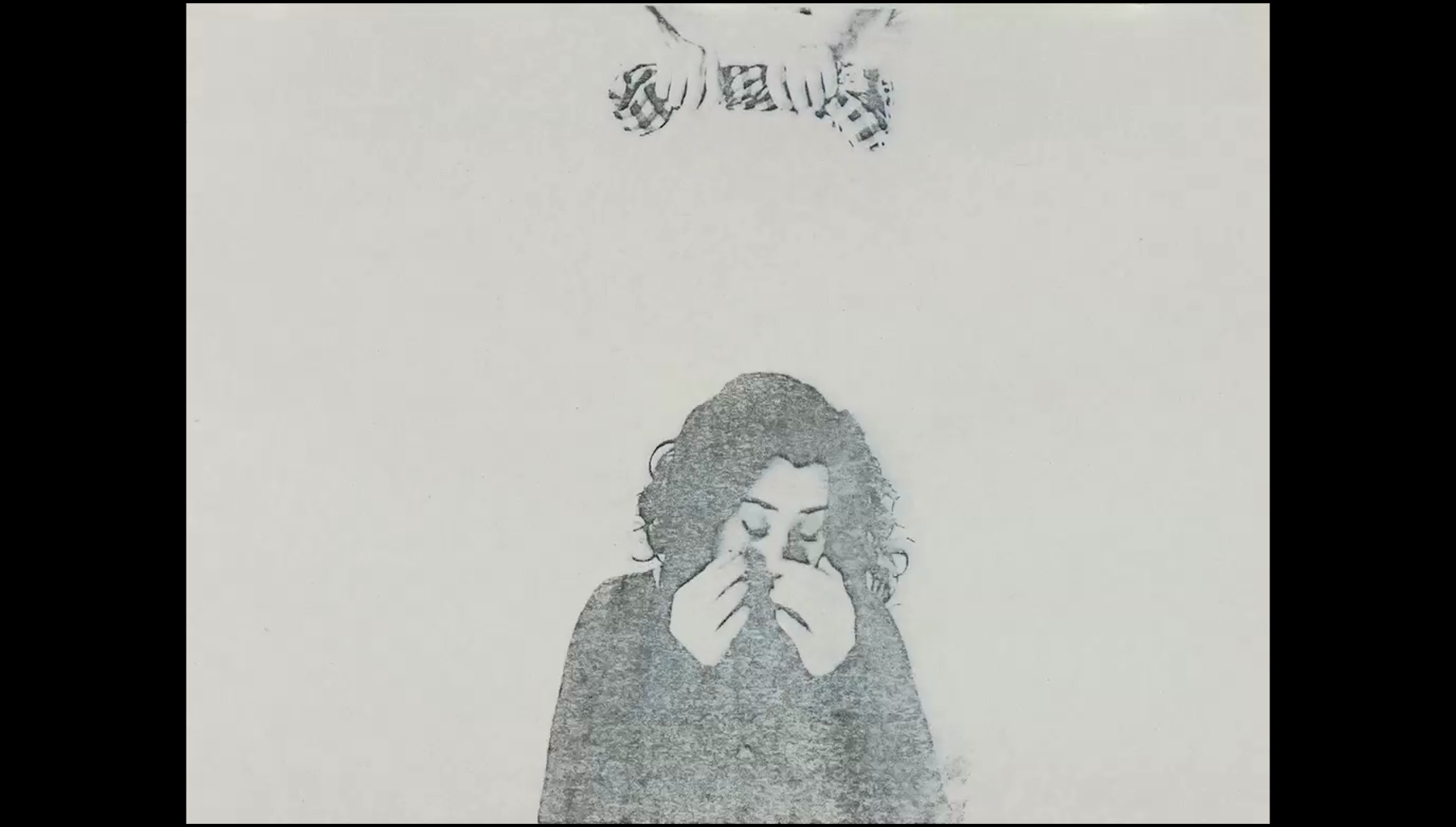
Payam Mofidi
Cohesive Disorder
2014
00:14:00
This video is one of a series of three videos in which the hands and the napkins are the principal components. They are metaphorical looks at the roles of religion and political powers; together these videos make a puzzle for the audience, yet also providing some clues. The hands and the napkins help the characters feel secure and comfortable, precisely at the time that they are getting drained, losing control of their own bodies and actions. Nonetheless, as with every metaphorical work, these codes are given to the spectator to make his/her own conclusion, and come to terms with an outcome, finding a unique individual meaning.
Cohesive Disorder
2014
00:14:00
This video is one of a series of three videos in which the hands and the napkins are the principal components. They are metaphorical looks at the roles of religion and political powers; together these videos make a puzzle for the audience, yet also providing some clues. The hands and the napkins help the characters feel secure and comfortable, precisely at the time that they are getting drained, losing control of their own bodies and actions. Nonetheless, as with every metaphorical work, these codes are given to the spectator to make his/her own conclusion, and come to terms with an outcome, finding a unique individual meaning.
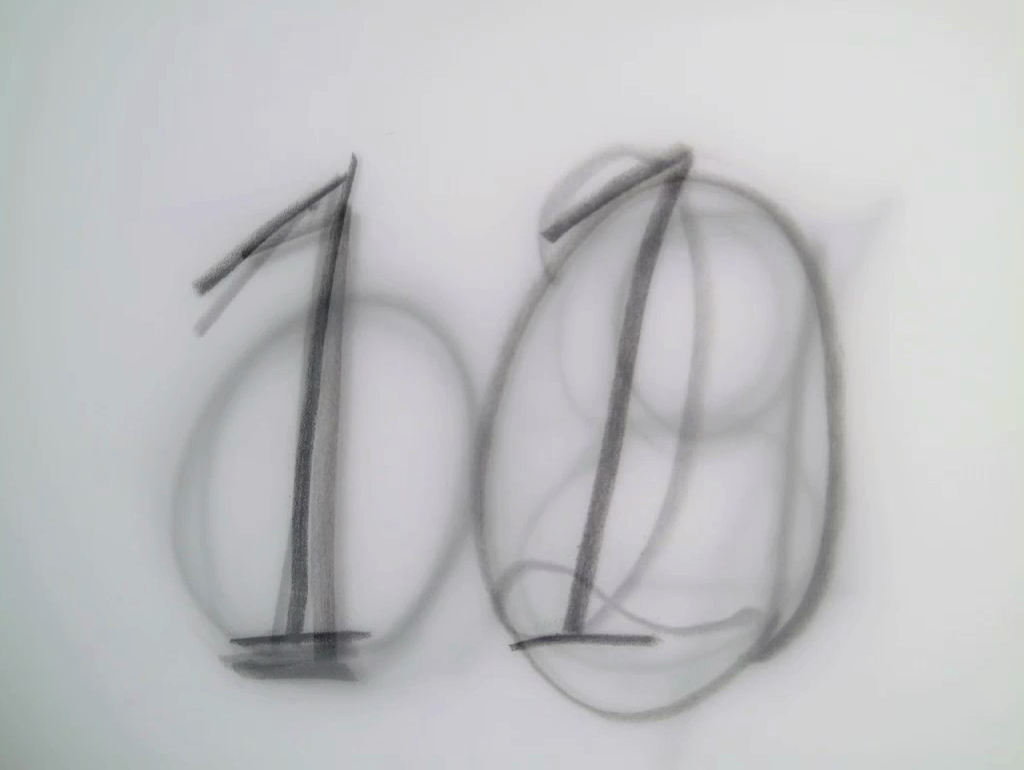
Sona Safaie Sooreh
Time
2010
00:01:38
Time is a hand-drawn video which deals with the relativity of time and the way it is understood differently. The video is an slideshow on 60 seconds that actually lasts 1 min and 38 seconds.
Time
2010
00:01:38
Time is a hand-drawn video which deals with the relativity of time and the way it is understood differently. The video is an slideshow on 60 seconds that actually lasts 1 min and 38 seconds.
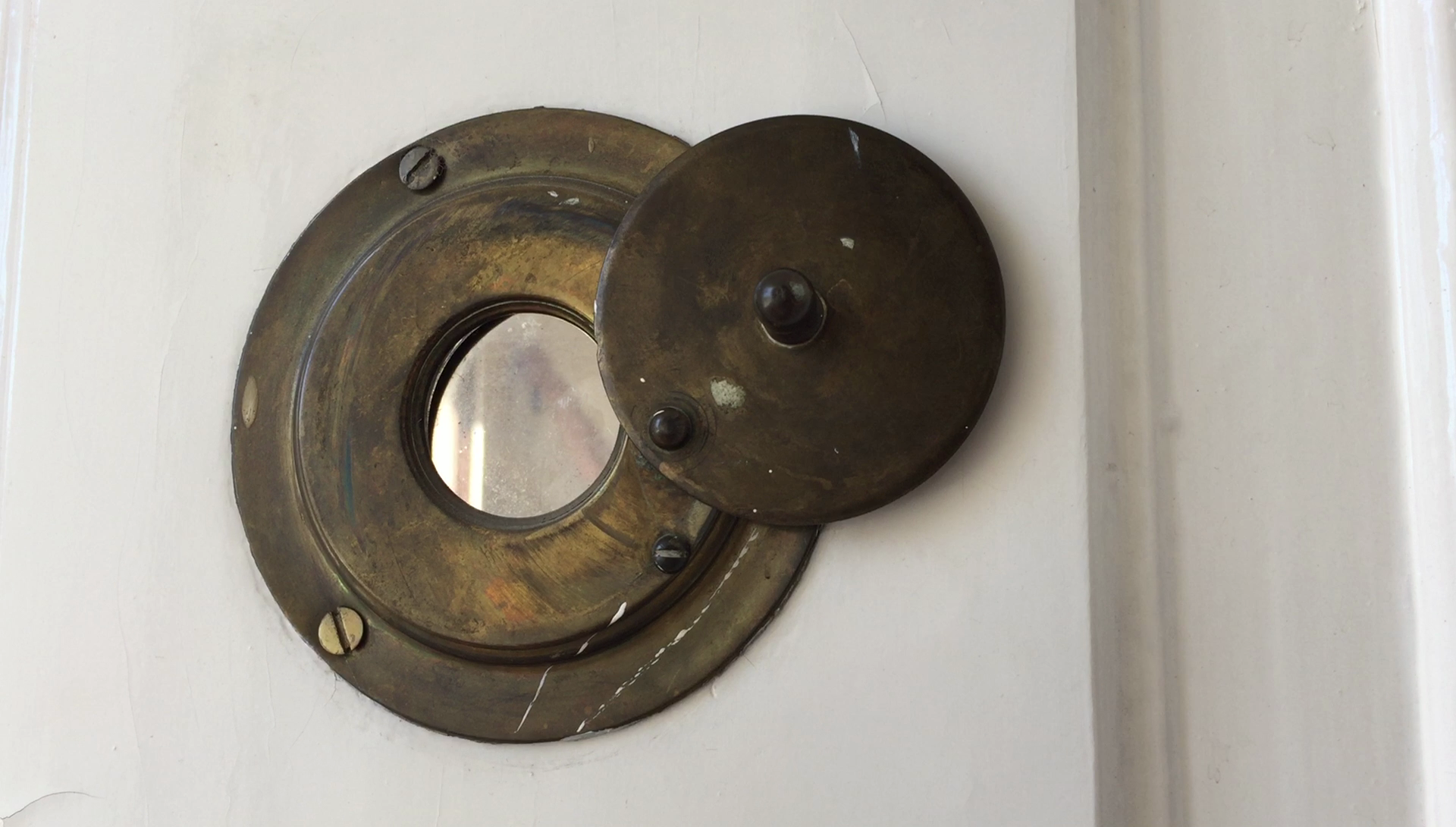
Farshido Larimian
IMG_2700
2016
00:06:53
without permission, but good.
IMG_2700
2016
00:06:53
without permission, but good.
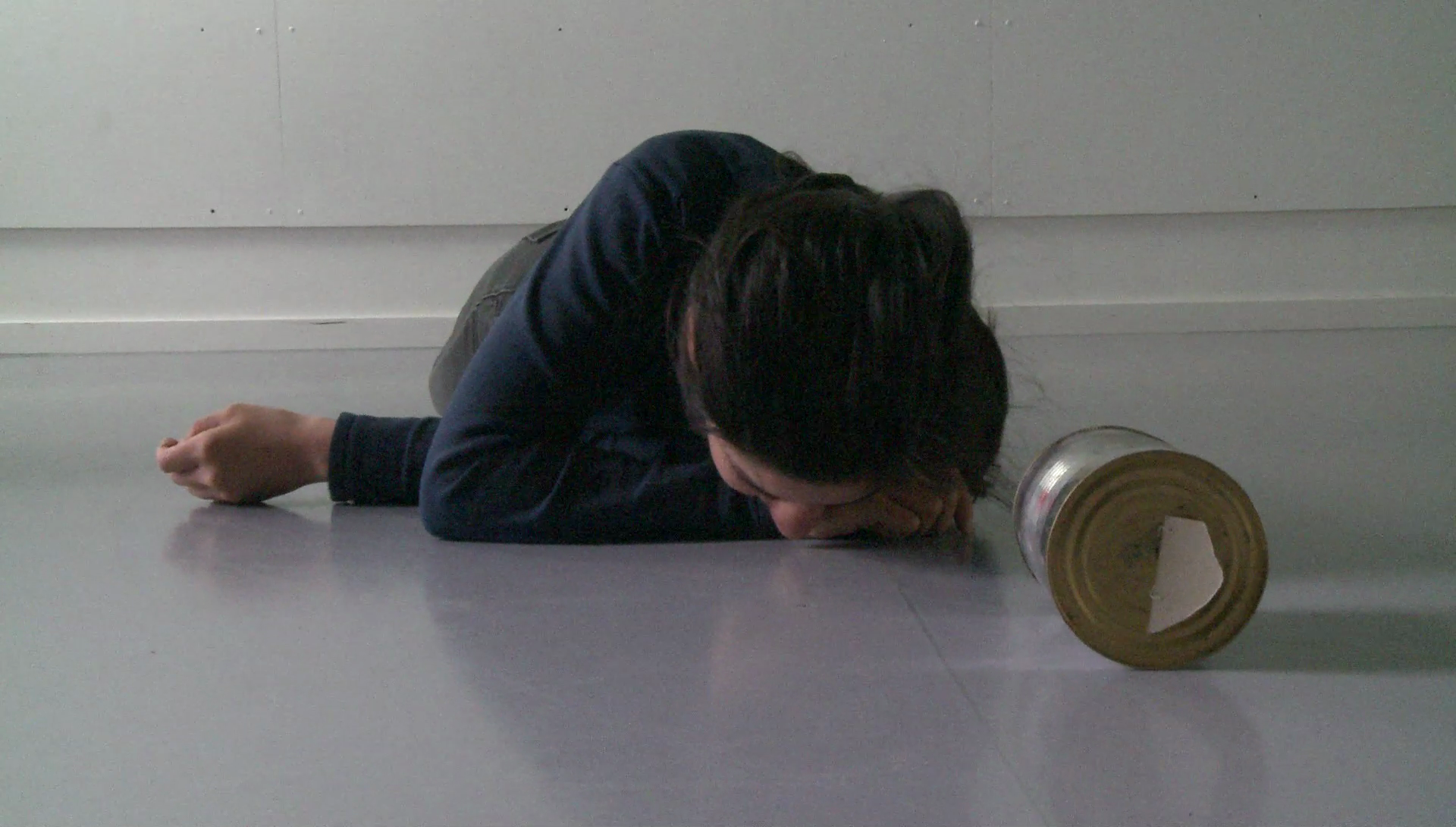
Ronak Moshtaghi
Metal-can, Paper, Thread
2015
00:01:27
The Short film, “Metal can-Paper-Thread” was firstly an attempt to activate a sculptural piece and explore ways to exhibit the object. During this process the result became more and more about the relationship of the Object, us and the space.
Metal-can, Paper, Thread
2015
00:01:27
The Short film, “Metal can-Paper-Thread” was firstly an attempt to activate a sculptural piece and explore ways to exhibit the object. During this process the result became more and more about the relationship of the Object, us and the space.
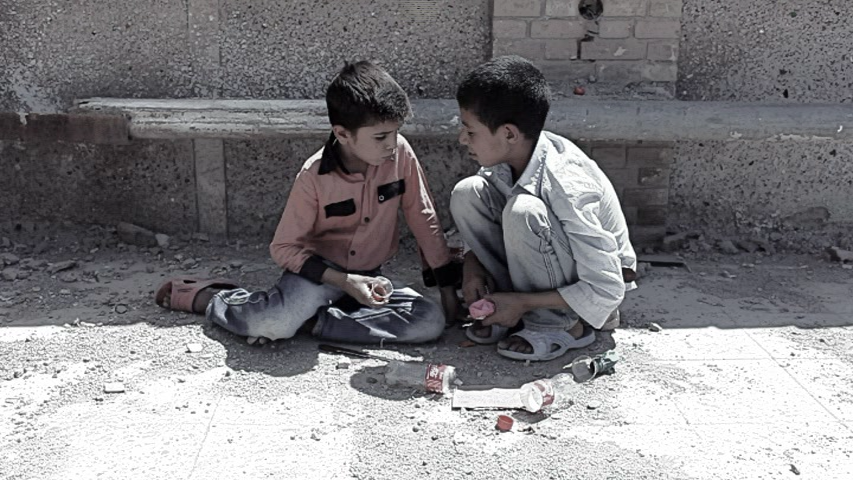
Nima Bahrehmand
We Are Well Self Equipped
2014
00:04:00
The piece follows the adventure of 2 boys, carefully building some tool from everyday materials.
We Are Well Self Equipped
2014
00:04:00
The piece follows the adventure of 2 boys, carefully building some tool from everyday materials.
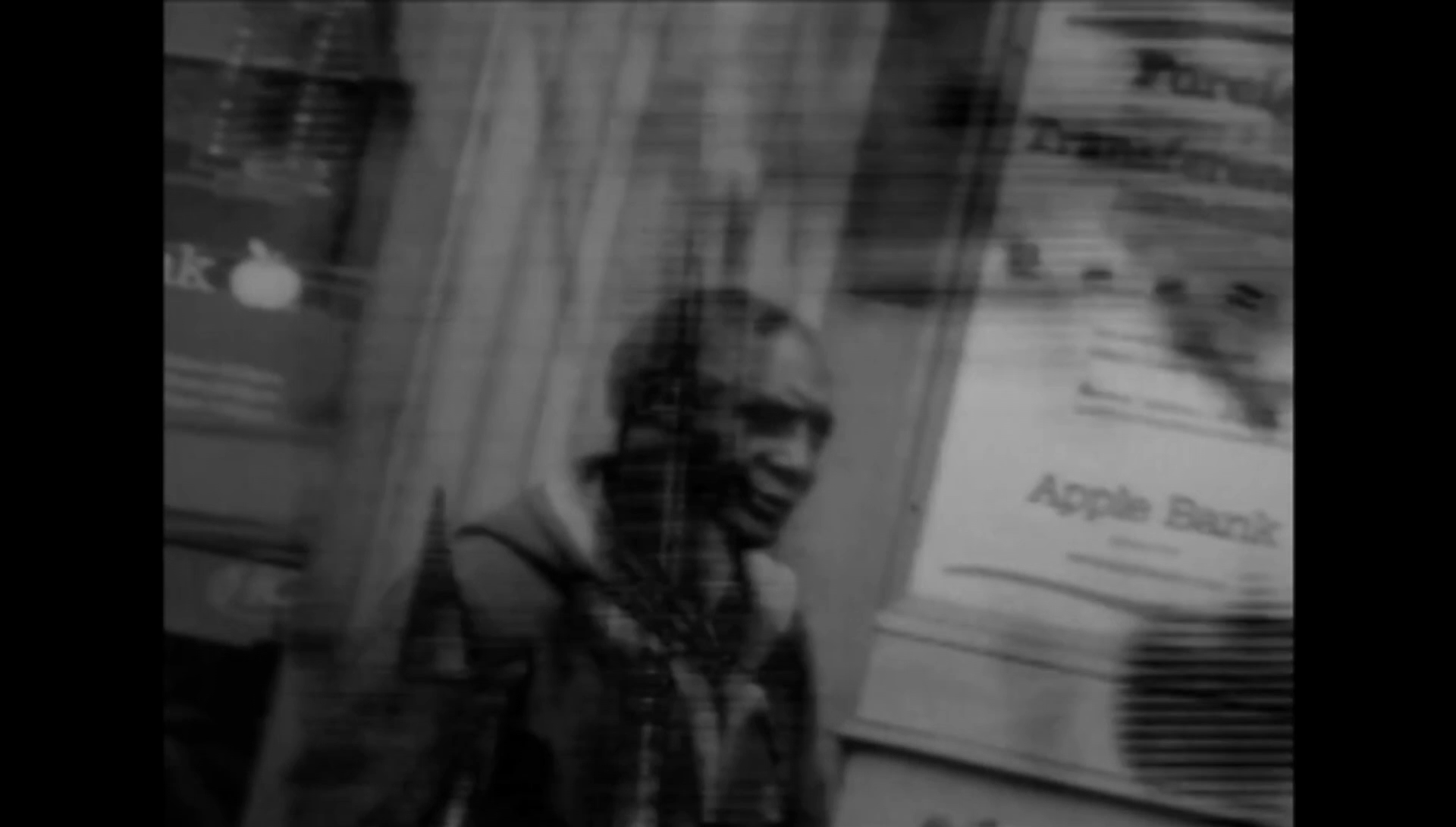
Raha Raissnia
Longing
2016
00:20:24
In 2014-15 I created several individual film works that for their starting point drew from much raw footage I took in a series of visits to a very poor neighborhood in New York's East Harlem in 2013. For all these works (except “Vioi") a specific soundtrack was created by Panagiotis Mavridis that uses instruments that he both built and designed. The first one in the series is titled “Longing", 16mm, color, 20 minutes with optical sound. This film was featured in The 56th Venice Biennale, All The World Futures, curated by Okwui Enwesor in 2015. The second film titled “Vioi" (16mm, B/W, silent) was presented as a 15-minute loop installation as part of solo exhibition in Madrid. This exhibition also included paintings that were informed and inspired directly by what I had experienced in East Harlem. The third piece, titled “Litany," consists of 20 film loops that are hand-painted and can only be performed live using two 16mm slot projectors. The fourth piece, “Vioi 3," consists of 80 B/W 35mm slides that are meant to be projected onto a double projection screen I designed that is unique in its kind. This piece can either be performed live or else exist as an installation where both the slides and the sound from the instruments would play as loops.
What has been of great importance to me about East Harlem and the area Chaleh Harz in my film by the same name in Iran, that I have tried to express and capture in my films is not the appalling poverty that is the most visible and known reality there but the integrity of the people I encountered there. I have tried to insist on expressing their heroism. What moved me the most in these areas was how despite deprivation and poverty the people there were animated, full of life, longing and living with great sense of humor, stripped of any pretension. In their organic way of being, some showed a serenity and strength I found to be valiant and noble. I have made these works as odes to the people of East Harlem and Chalet Harz. The hidden camera and my inability to frame what I was capturing caused sweeping and erratic movements that resulted in abstractions throughout the films. Therefore these effects are not there in order to create any aesthetic quality or else evade figuration but are just part of the motion of real life captured on film through my bodily movements.
“Chaleh Harz", 2011, used as its starting point raw footage I took with a Super 8 camera in the slums of Darvazeh Ghar, one of Tehran's poorest neighborhoods, south of the Grand Bazaar. For this film and all the most recent works related to East Harlem that includes “ Longing” I rephotographed and refilmed all the raw footage in the studio and combined it with some found imagery and hand-painted slides that were relevant in form and content through a very layered process that involved projection onto paintings and various types of screens, using both digital and film cameras. I later edited down all these materials and transferred them to 16mm films.
“Chaleh Harz" is a nickname people use in Iran for the slums of Darvazeh Ghar that translates to “Useless Ditch". “Vioi" which is the title I have used for several pieces related to East Harlem, means‚ “Lives" in Greek. The name is derived from a group of religious texts that describe the lives and the martyrdom of Eastern Orthodox saints during the Byzantine period. These men lived in the margins with much poverty.
My film work can be associated with expanded cinema practice, as I manipulate cinema's structural elements in regards to space, time, projectors and screens in live performances and loop installations. My process is layered and permutational. It makes use of both old and new technologies and relies heavily on what my hands can achieve. All three areas of my practice- painting, drawing and filmmaking - are interconnected and interdependent. My films and paintings influence one another, and through creating drawings, I investigate this influence. Music and sound play a major role in both inspiring and forming completed works. My work aspires to the temporal and experiential condition of music‚-- suggestive, ambiguous, abstract. What reveals itself as a subject matter in all my work is human vulnerability. Although at times my work seems to allude to the dismal, my philosophy is optimistic and affirms human integrity. What I seek and reach out to find in the most tenebrous subjects is subtlety, beauty and innocence.
Longing
2016
00:20:24
In 2014-15 I created several individual film works that for their starting point drew from much raw footage I took in a series of visits to a very poor neighborhood in New York's East Harlem in 2013. For all these works (except “Vioi") a specific soundtrack was created by Panagiotis Mavridis that uses instruments that he both built and designed. The first one in the series is titled “Longing", 16mm, color, 20 minutes with optical sound. This film was featured in The 56th Venice Biennale, All The World Futures, curated by Okwui Enwesor in 2015. The second film titled “Vioi" (16mm, B/W, silent) was presented as a 15-minute loop installation as part of solo exhibition in Madrid. This exhibition also included paintings that were informed and inspired directly by what I had experienced in East Harlem. The third piece, titled “Litany," consists of 20 film loops that are hand-painted and can only be performed live using two 16mm slot projectors. The fourth piece, “Vioi 3," consists of 80 B/W 35mm slides that are meant to be projected onto a double projection screen I designed that is unique in its kind. This piece can either be performed live or else exist as an installation where both the slides and the sound from the instruments would play as loops.
What has been of great importance to me about East Harlem and the area Chaleh Harz in my film by the same name in Iran, that I have tried to express and capture in my films is not the appalling poverty that is the most visible and known reality there but the integrity of the people I encountered there. I have tried to insist on expressing their heroism. What moved me the most in these areas was how despite deprivation and poverty the people there were animated, full of life, longing and living with great sense of humor, stripped of any pretension. In their organic way of being, some showed a serenity and strength I found to be valiant and noble. I have made these works as odes to the people of East Harlem and Chalet Harz. The hidden camera and my inability to frame what I was capturing caused sweeping and erratic movements that resulted in abstractions throughout the films. Therefore these effects are not there in order to create any aesthetic quality or else evade figuration but are just part of the motion of real life captured on film through my bodily movements.
“Chaleh Harz", 2011, used as its starting point raw footage I took with a Super 8 camera in the slums of Darvazeh Ghar, one of Tehran's poorest neighborhoods, south of the Grand Bazaar. For this film and all the most recent works related to East Harlem that includes “ Longing” I rephotographed and refilmed all the raw footage in the studio and combined it with some found imagery and hand-painted slides that were relevant in form and content through a very layered process that involved projection onto paintings and various types of screens, using both digital and film cameras. I later edited down all these materials and transferred them to 16mm films.
“Chaleh Harz" is a nickname people use in Iran for the slums of Darvazeh Ghar that translates to “Useless Ditch". “Vioi" which is the title I have used for several pieces related to East Harlem, means‚ “Lives" in Greek. The name is derived from a group of religious texts that describe the lives and the martyrdom of Eastern Orthodox saints during the Byzantine period. These men lived in the margins with much poverty.
My film work can be associated with expanded cinema practice, as I manipulate cinema's structural elements in regards to space, time, projectors and screens in live performances and loop installations. My process is layered and permutational. It makes use of both old and new technologies and relies heavily on what my hands can achieve. All three areas of my practice- painting, drawing and filmmaking - are interconnected and interdependent. My films and paintings influence one another, and through creating drawings, I investigate this influence. Music and sound play a major role in both inspiring and forming completed works. My work aspires to the temporal and experiential condition of music‚-- suggestive, ambiguous, abstract. What reveals itself as a subject matter in all my work is human vulnerability. Although at times my work seems to allude to the dismal, my philosophy is optimistic and affirms human integrity. What I seek and reach out to find in the most tenebrous subjects is subtlety, beauty and innocence.

